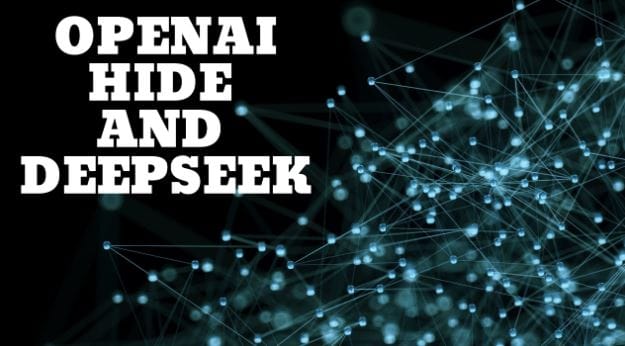Open AI Hide and DeepSeek
In the rapidly evolving landscape of artificial intelligence, a Chinese startup named DeepSeek has emerged as a disruptive force, challenging the dominance of U.S. tech giants and reshaping our understanding of AI development

In the rapidly evolving landscape of artificial intelligence, two companies have emerged as key players reshaping the industry: OpenAI and DeepSeek. Their contrasting approaches and recent breakthroughs have sent shockwaves through the global tech sector, triggering a reevaluation of AI development strategies and market dynamics.
OPENAI: Origins and Early Years (2015-2018)
OpenAI was founded in December 2015 by a group of tech luminaries including Sam Altman, Elon Musk, Greg Brockman, Reid Hoffman, Jessica Livingston, and Peter Thiel. The organization started as a nonprofit with a pledge of over $1 billion, though only $130 million was actually collected by 2019.The founders' mission was to ensure that artificial general intelligence (AGI) would benefit humanity as a whole. Initially headquartered in Brockman's living room before moving to San Francisco's Mission District, OpenAI aimed to freely collaborate with other institutions by making its patents and research open to the public. The organization attracted top AI researchers by offering competitive salaries, though not quite matching those of tech giants like Google or Facebook.
Transition to "Capped-Profit" Model (2018-2021)
By 2018, OpenAI recognized the need for significant resources to advance AGI research. This led to the introduction of a "capped-profit" model, allowing investments while ensuring excess revenue would be reinvested in their core mission. This shift caused friction within the founding team, resulting in Elon Musk's departure in February 2018
Key Technological Developments
2016: OpenAI Gym
OpenAI released a toolkit for testing and improving reinforcement learning algorithms, accelerating advancements in this crucial area of AI
2017: OpenAI Five
A computer program that plays Dota 2, demonstrating AI's capability in communication-based scenarios by defeating professional players
2020: GPT-3
The release of GPT-3, a powerful language model with 175 billion parameters, marked a significant milestone in natural language processing
2021: DALL-E
OpenAI introduced DALL-E, a deep learning model capable of generating complex digital images from textual descriptions
Governance Challenges and Board Issues
OpenAI's unique governance structure, combining a nonprofit that controls a for-profit entity, has faced significant challenges. The board's composition and decision-making processes came under scrutiny in November 2023 when Sam Altman was briefly ousted as CEO, triggering a crisis that nearly destroyed the company's $80 billion valuation. This event highlighted the inherent instability in OpenAI's governance model, which lacked clear guidelines for critical decisions and conflict resolution. The incident also revealed the limitations of the company's charter, which at less than 500 words, provided insufficient guidance for complex situations
Recent Developments and Future Directions
As of January 2025, OpenAI continues to push the boundaries of AI research and development. The company has released its o3 model, achieving a breakthrough score of 91.5% on a key reasoning benchmark. OpenAI is also working on:
- A successor to GPT-4o with enhanced capabilities
- Improved memory and longer context for AI models
- A potential "grown-up mode" with fewer guardrails
- Significant updates to Sora, their video generation model
- More personalization features
Technical Challenges and Innovations
OpenAI has tackled numerous technical challenges in its quest to develop advanced AI models:
- Scaling language models to billions of parameters while maintaining coherence and factual accuracy
- Developing efficient training techniques to handle massive datasets
- Implementing safety measures and ethical considerations into AI systems
- Advancing reinforcement learning algorithms for complex decision-making tasks
- Creating multimodal AI models capable of processing and generating various types of data (text, images, video)
These papers and articles have contributed to advancements in transformer architectures, reasoning capabilities, efficient training techniques, and benchmarking methods for large language models
- "Attention Is All You Need" (Vaswani et al., 2017) - Introduced the transformer architecture
- "Language Models are Few-Shot Learners" (Brown et al., 2020) - Describes GPT-3
- "Training language models to follow instructions with human feedback" (Ouyang et al., 2022) - Introduces InstructGPT
- "Chain-of-Thought Prompting Elicits Reasoning in Large Language Models" (Wei et al., 2022) - Describes chain-of-thought reasoning
- "Abstraction and Reasoning Corpus for Artificial General Intelligence" (Chollet, 2019) - Introduces the ARC-AGI benchmark
- "How to Train Data-Efficient LLMs" (arXiv:2402.09668, 2024) - Explores data-efficient approaches for pre-training LLMs
The Rise of DeepSeek: A Paradigm Shift in AI Development
In the rapidly evolving landscape of artificial intelligence, a Chinese startup named DeepSeek has emerged as a disruptive force, challenging the dominance of U.S. tech giants and reshaping our understanding of AI development. This article explores DeepSeek's journey, from its origins to its current position at the forefront of AI innovation, set against the backdrop of U.S.-China technological competition and global AI advancements.
Origins and Founding
DeepSeek's story begins with Liang Wenfeng, an AI enthusiast who started trading during the 2007-2008 financial crisis while attending Zhejiang University. In February 2016, Liang co-founded High-Flyer, a hedge fund focused on developing and using AI trading algorithms. By 2021, High-Flyer had transitioned to exclusively using AI in its trading operations, showcasing Liang's commitment to artificial intelligence. In April 2023, High-Flyer established an artificial general intelligence (AGI) lab dedicated to AI research separate from its financial business. This lab was spun off into its own company, DeepSeek, in May 2023, with High-Flyer as one of the primary investors. Unlike many startups in the AI space, DeepSeek faced reluctance from venture capital firms due to the long-term nature of its research goals, which were unlikely to generate quick returns.
U.S. AI Policy Context
As DeepSeek was taking shape, the United States was actively developing its AI strategy. In May 2023, the National Science Foundation dedicated $140 million to launch seven new National AI Research Institutes, aiming to promote responsible innovation and strengthen the U.S. AI research infrastructure. The Biden-Harris administration also secured voluntary commitments from leading AI companies to ensure safe, secure, and transparent development of AI technology. In August 2023, the Department of Homeland Security issued Policy Statement 139-06, outlining guidelines for the acquisition and use of AI by DHS components in a manner consistent with the Constitution and applicable laws. These efforts underscored the U.S. government's commitment to maintaining leadership in AI development while addressing ethical and security concerns.
DeepSeek's Technological Journey
DeepSeek's approach to AI development has been characterized by efficiency and innovation. The company has leveraged its resources, including a significant stockpile of Nvidia A100 GPUs acquired before U.S. export restrictions were imposed. Estimates of DeepSeek's GPU holdings range from 10,000 to as high as 50,000 units, providing substantial computational power for AI model training.
Key Innovations:
- Mixture-of-Experts (MoE) Architecture: DeepSeek's flagship model, DeepSeek-V3, employs an MoE architecture with 671 billion parameters. However, it activates only 37 billion parameters per token, significantly reducing computational overhead while maintaining high performance.
- FP8 Mixed Precision Training: By utilizing 8-bit floating-point precision, DeepSeek accelerates computations and reduces memory usage without sacrificing accuracy.
- Multi-Token Prediction (MTP): This technique enables simultaneous prediction of multiple tokens, improving inference speed and efficiency.
- Resource Optimization: DeepSeek has demonstrated remarkable efficiency in model development. Its DeepSeek-V3 model was trained for just $5.6 million using 2.78 million GPU hours on Nvidia H800 chips, which are less powerful than the H100 GPUs used by competitors like OpenAI and Meta.
Performance Benchmarks and Comparisons
DeepSeek's models have shown impressive performance across various benchmarks, often rivaling or surpassing those of leading U.S. companies:
- Mathematics: DeepSeek-V3 outperformed GPT-4 and Claude 3.5 on benchmarks like MATH-500 and AIME 2024.
- Reasoning Capabilities: The recently released DeepSeek R1 model has demonstrated reasoning abilities comparable to OpenAI's o1, a frontier model known for its advanced capabilities.
- Chatbot Performance: Two DeepSeek models ranked in the top 10 on Chatbot Arena, a platform hosted by University of California, Berkeley researchers that rates chatbot performance.
- App Store Rankings: On January 27, 2025, DeepSeek's AI assistant, powered by DeepSeek-V3, became the top-rated free app on Apple's App Store in the U.S., overtaking ChatGPT.
Technological Challenges and Solutions
DeepSeek has faced several challenges in its quest to compete with U.S. AI giants:
- Hardware Limitations: U.S. export controls restricted access to advanced AI chips. DeepSeek overcame this by optimizing its models for efficiency on less powerful hardware.
- Data Access: While China's less restrictive data privacy laws provide advantages, DeepSeek still needed to develop strategies for effective data utilization.
- Talent Acquisition: Instead of hiring experienced engineers, DeepSeek recruited recent PhD graduates from top Chinese universities, fostering a culture of innovation and dedication to research1.
Open-Source Strategy and Impact
DeepSeek's commitment to open-source development has been a key differentiator:
- MIT License: DeepSeek R1 was released under an MIT license, allowing free commercial use and modification.
- Community Engagement: By making its models open-source, DeepSeek has encouraged global collaboration and innovation in AI development.
- Cost-Effectiveness: DeepSeek's open-source models offer high performance at a fraction of the cost of proprietary alternatives, potentially disrupting the AI market.
Geopolitical Implications
DeepSeek's rapid progress has significant implications for the global AI landscape:
- U.S.-China Tech Competition: DeepSeek's success challenges the notion that massive investments in AI chip development are necessary for dominance, potentially shifting the dynamics of the U.S.-China tech rivalry.
- Export Control Effectiveness: The company's ability to innovate around hardware constraints raises questions about the long-term effectiveness of U.S. export controls on AI technologies5.
- Global AI Ecosystem: DeepSeek's open-source approach could lead to a more distributed and collaborative global AI development ecosystem, potentially challenging the current U.S.-centric model.
Industry Implications
OpenAI and DeepSeek have both made significant advancements in AI models, with distinct approaches to architecture and training. Here's a detailed comparison of their latest models:
OpenAI o3
Architecture:
- Generative pre-trained transformer (GPT) model
- Uses a "private chain of thought" approach for reasoning
- Available in two versions: o3 and o3-mini
Key Features:
- Reinforcement learning to "think" before generating answers
- Improved performance on complex tasks like coding, mathematics, and science
- Three compute levels for o3-mini: low, medium, and high
Performance:
- GPQA Diamond benchmark: 87.7% score
- SWE-bench Verified: 71.7% accuracy
- Codeforces: 2727 Elo score
- ARC-AGI benchmark: 3x accuracy of o1
- ARC-AGI-1 Public Training set: 75.7% on Semi-Private Evaluation set (87.5% with high-compute configuration)
DeepSeek-V3 and R1
Architecture:
- Mixture-of-Experts (MoE) model with 671 billion parameters
- Only 37 billion parameters activated per token
- Uses DualPipe communication accelerator for efficient data transfer
Key Features:
- Trained on 14.8 trillion tokens
- Utilizes 32 of 132 streaming multiprocessors on Hopper GPU for communication acceleration
- Incorporates post-training stages including Supervised Fine-Tuning (SFT) and Reinforcement Learning (RL)
Performance:
- Comparable to OpenAI's o1 on reasoning benchmarks
- DeepSeek-R1 achieves 97.3% accuracy on MATH-500 benchmark
- Reaches 96.3 percentile on Codeforces
Cost Efficiency:
- Developed for less than $6 million in two months
- API costs $0.14 to $0.55 per million input tokens (6.5x more for R1 model)
Both models showcase significant advancements, but with different approaches. OpenAI o3 focuses on improved reasoning capabilities through its "private chain of thought" approach, while DeepSeek emphasizes cost-efficiency and resource optimization through its MoE architecture. DeepSeek's model demonstrates comparable performance to OpenAI's offerings at a fraction of the cost, potentially disrupting the AI industry's focus on massive computational resources. Both models incorporate advancements in transformer architectures, reinforcement learning, and efficient training techniques detailed below.
Transformer Architectures
Transformer models, introduced in the paper "Attention Is All You Need" (Vaswani et al., 2017), form the foundation of modern large language models. Key components include:
- Self-Attention Mechanism: Allows the model to weigh the importance of different parts of the input sequence when processing each element.
- Multi-Head Attention: Enables the model to attend to information from different representation subspaces at different positions.
- Positional Encoding: Injects information about the relative or absolute position of tokens in the sequence.
- Feed-Forward Networks: Process the attention output through fully connected layers.
- Layer Normalization and Residual Connections: Stabilize training and allow for deeper networks.
Recent advancements in transformer architectures include:
- Sparse Attention: Reduces computational complexity by attending to only a subset of the input (e.g., Longformer, BigBird).
- Mixture of Experts (MoE): Activates only a subset of the model's parameters for each input, improving efficiency (e.g., Switch Transformers, DeepSeek's MoE architecture).
- Rotary Position Embedding (RoPE): Improves the model's ability to understand relative positions without explicit position embeddings.
Reinforcement Learning (RL) in Language Models
Reinforcement Learning from Human Feedback (RLHF) has become crucial in aligning language models with human preferences. Key concepts include:
- Policy Optimization: Techniques like Proximal Policy Optimization (PPO) are used to update the model's policy based on feedback.
- Reward Modeling: A separate model is trained to predict human preferences, which then guides the RL process.
- Exploration vs. Exploitation: Balancing between exploring new behaviors and exploiting known good behaviors.
- Off-Policy Learning: Allows the model to learn from data generated by a different policy, crucial for efficient training.
Efficient Learning Techniques
Several techniques have been developed to make training and inference of large language models more efficient:
- Distributed Training: Splitting the model or data across multiple GPUs or TPUs to parallelize computation.
- Mixed Precision Training: Using lower precision (e.g., 16-bit or 8-bit) arithmetic to reduce memory usage and increase speed.
- Gradient Checkpointing: Trades computation for memory by recomputing activations during backpropagation instead of storing them.
- Efficient Attention Mechanisms: Techniques like Flash Attention or Multi-Query Attention reduce the memory and computational requirements of attention operations.
- Quantization: Reducing the precision of model weights and activations post-training to improve inference speed and reduce memory usage.
- Knowledge Distillation: Training smaller models to mimic the behavior of larger models.
Key Subjects Contributing to These Products
1. Natural Language Processing (NLP)
NLP is a subfield of artificial intelligence focused on enabling computers to understand, interpret, and generate human language. Key components include:
- Syntax: Analyzing sentence structure and grammar
- Semantics: Understanding the meaning of words and phrases
- Pragmatics: Interpreting context and intent
- Discourse: Analyzing connections between sentences and larger text structures
NLP techniques like tokenization, part-of-speech tagging, and named entity recognition form the foundation for processing text data in large language models
2. Deep Learning
Deep learning involves neural networks with multiple layers that can learn hierarchical representations of data. Key concepts include:
- Neural network architectures (e.g., transformers)
- Backpropagation for training
- Activation functions
- Regularization techniques
Deep learning is central to the architecture of models like o3 and DeepSeek-V3, enabling them to process and generate human-like text1.
3. Information Theory
Information theory provides a mathematical framework for quantifying information and uncertainty. In the context of AI and deep learning, it's used for:
- Measuring model performance
- Optimizing data compression
- Analyzing information flow in neural networks
The Information Bottleneck theory, for example, has been applied to understand the training dynamics of deep neural networks
4. Linear Algebra and Calculus
These mathematical foundations are crucial for implementing and optimizing neural networks:
- Matrix operations for efficient computations
- Gradient descent and other optimization algorithms
- Tensor operations for multi-dimensional data processing
5. Distributed Systems
Distributed computing is essential for training large models across multiple machines:
- Data parallelism: Splitting data across multiple nodes
- Model parallelism: Dividing the model architecture across nodes
- Pipeline parallelism: Splitting the model into stages processed by different nodes
These techniques enable efficient training of massive models like DeepSeek-V3 with 671 billion parameters
6. Computer Architecture
Understanding hardware capabilities is crucial for optimizing model performance:
- GPU/TPU architectures for parallel processing
- Memory hierarchies and caching strategies
- Interconnect technologies for distributed training
Specialized AI accelerators and high-performance interconnects are key to scaling up model training
7. Optimization Theory
Advanced optimization techniques are essential for training large-scale models:
- Stochastic gradient descent variants
- Adaptive learning rate methods
- Second-order optimization algorithms
These methods help models converge faster and achieve better performance9.
8. Probability Theory and Statistics
Probabilistic modeling underpins many aspects of machine learning:
- Bayesian inference
- Statistical learning theory
- Sampling techniques (e.g., for language model generation)
9. Cognitive Science and Linguistics
Insights from human language processing inform model design:
- Psycholinguistics
- Cognitive architectures
- Language acquisition theories
10. Ethics and Fairness in AI
Responsible AI development is crucial:
- Bias detection and mitigation
- Privacy-preserving techniques
- Interpretability and explainability methods
11. Software Engineering
Large-scale software design practices are necessary for developing and deploying complex AI systems:
- Distributed version control
- Continuous integration and deployment
- Microservices architecture
12. Data Management
Efficient handling of massive datasets is critical:
- Distributed storage systems
- Data preprocessing pipelines
- Efficient data loading and caching strategies
These subjects collectively enable the development of cutting-edge language models, pushing the boundaries of AI capabilities in natural language understanding and generation.
The contrasting approaches of OpenAI and DeepSeek have significant implications for the AI industry:
- Democratization of AI: DeepSeek's cost-effective, open-source models are making advanced AI capabilities more accessible to developers and smaller organizations
- Efficiency vs. Scale: DeepSeek's success challenges the notion that massive computational resources are necessary for cutting-edge AI development
- Market Dynamics: The emergence of DeepSeek has led to a reevaluation of AI companies' valuations, with major tech stocks experiencing significant drops
- Geopolitical Considerations: DeepSeek's rapid progress has raised concerns about the effectiveness of U.S. export controls on AI technologies and the shifting dynamics of U.S.-China technological competition
- Future of AI Development: The industry may see a shift towards more specialized, efficient models developed by domain experts, rather than relying solely on general-purpose models from major tech companies
DeepSeek's journey from a hedge fund spinoff to a leading AI innovator exemplifies the rapid pace of advancement in artificial intelligence. By leveraging efficient architectures, innovative training techniques, and an open-source philosophy, DeepSeek has demonstrated that breakthrough AI development is possible even with resource constraints. As the global AI race intensifies, DeepSeek's success serves as a reminder that innovation often thrives under pressure. The company's ability to compete with and sometimes surpass U.S. tech giants highlights the dynamic nature of AI research and the potential for disruptive advancements from unexpected sources. Moving forward, the AI community will be watching closely to see how DeepSeek's models evolve and what impact they will have on the broader technological landscape. As we navigate this new era of AI development, it's clear that the interplay between open-source collaboration, efficient resource utilization, and geopolitical considerations will shape the future of artificial intelligence.











